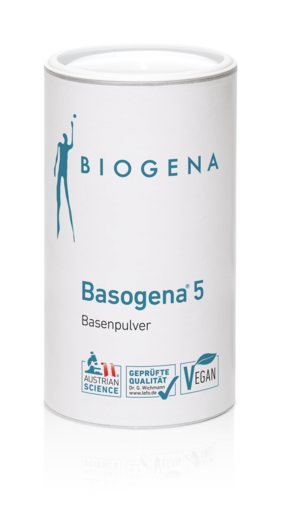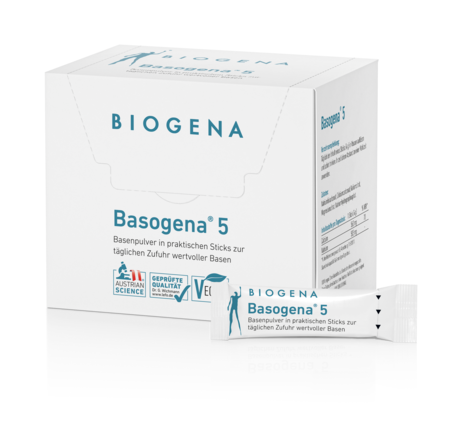Mineral substances
Minerals are inanimate substances that are vital for our body. Only with their help can we build it and run our metabolism. This makes it all the more important to supply the body with sufficient minerals through our diet.



Minerals – necessary for life
Particular attention should be paid to the mineral balance, particularly in cases of increased need, such as during growth, pregnancy/lactation or in competitive athletes.
What are minerals and why are they important?
Minerals are natural, inorganic substances that are essential (= vital) for us humans. Whether we're growing, dancing or digesting – nothing works without them. Among other things, minerals serve as building blocks for bones, teeth, hair and nails, and are the basis for our fluid balance, nerve stimulation and hormonal processes. Special attention should be paid to the mineral balance in our bodies when requirements are increased, for example when the body is growing, during pregnancy/breastfeeding or for competitive athletes. Since our body cannot produce these nutrients itself, they must be supplied daily in sufficient quantities through our diet.
What is the difference between trace and quantitative elements?
Minerals can be divided into quantitative elements and trace elements. The names say it all: while our body needs "a high quantity" of the quantitative elements, just "traces" of the trace elements are sufficient for our body. Accordingly, the former are found in our organism in higher quantities (over 50mg per kilogram of body weight), while the latter are only present in low concentrations (less than 50mg per kilogram of body weight). An exception to this rule is iron, which belongs to the trace elements due to its functions – despite its content of approx. 60 mg per kilogram of body weight.
That's the theory, at least! In practice, however, the term minerals – confusing to some – is often used synonymously for quantitative elements, while the distinction is maintained for trace elements.
What minerals are there and which ones does the body need?
The quantitative elements and most important trace elements at a glance:
Each of these minerals performs important tasks in our body. That's why it is important to make sure that our body is always sufficiently supplied with all of these minerals – because if one is missing, none of the others can replace it.
The most important minerals - aka bulk elements
Calcium
Calcium is the fifth most common element in the Earth's crust and is accordingly widely found in bodies of water, rocks, soils, and living beings. The human body contains approximately one kilo of calcium, which is almost entirely present in the bones. This distribution reflects the relevance of this mineral for the skeleton. In addition to maintaining normal bones and teeth, calcium contributes to normal muscle and nerve functions and normal blood clotting.
In animal foods, calcium is readily available in milk and dairy products in significant quantities. Broccoli, kale, and fennel are also considered calcium-rich. The calcium requirement can also be covered by nuts such as Brazil nuts, hazelnuts, or almonds
Magnesium
Magnesium is involved in almost all the metabolic processes in the cell. It is particularly important for muscle function, the nerves and the nervous system, the creation of strong teeth and bones as well as for the electrolyte balance in the body.
Magnesium – as an important component of chlorophyll – is mainly found in green vegetables. Magnesium is also contained in oat flakes, nuts, legumes, and whole grain products. The demand can be met by animal products such as fish, meat, milk, and dairy products.
Sodium
Sodium is the most common and widespread electrolyte in the extracellular (= outside the cells) area. In our diet, we usually come across sodium in the form of table salt (= sodium chloride). While the so-called "white gold" used to be a highly sought-after but scarce raw material, nowadays the tide has completely turned. Today, experts are constantly discussing the negative consequences of excessive salt consumption.
Potassium
Potassium is the fourth most abundant element in our body. In contrast to its counterpart sodium, potassium is mainly found inside the cell (98%). This element is particularly important for maintaining normal blood pressure, nerve function and muscle function.
Ample amounts of potassium are found primarily in plant foods – especially in pulses, fruits and vegetables, and whole-grain products. Animal-based foods, fats, oils and highly processed foods, on the other hand, are generally considered to be low in potassium.
Chloride
Chloride is mainly found in the extracellular (= outside the cells) space and is an important partner for sodium. The element is a component of our stomach acid and through its formation contributes to normal digestion.
Phosphorus
Phosphorus plays a role in numerous tasks within the body. For example, it supports normal energy metabolism and the normal function of cell membranes. Phosphorus is also involved in the maintenance of healthy bones and teeth. In our diet, we encounter this quantitative element in almost all foods – with animal-based sources providing more usable phosphorus than plant-based sources.
Sulphur
Everyone knows calcium and magnesium. Sulphur, on the other hand, leads to a rather shadowy existence, even though it is the third most common quantitative element in the body. This is because it is absorbed in food in a bound form (e.g. through the two sulphur-containing amino acids, cysteine and methionine), and therefore tends not to be perceived as a quantitative element in its own right, but is seen in a different context.
In our diet, sulphur is contained in numerous foods – especially in protein sources, such as meat, eggs and dairy products. However, certain plant-based foods, such as garlic, onions and cabbages, are also considered sources of sulphur.
An overview of minerals and their tasks & functions
Minerals can perform different functions in the body – but some tasks they share with each other. An overview of the most important functions:
Mineral and its task/function | (Estimated) recommended intake for adults according to the DGE |
Calcium supports...
| 1000 Men/1000 Women |
Magnesium supports...
| 350 Men/300 Women |
Potassium supports ...
| 4000 Men/4000 Women |
Chloride supports...
| 2300 Men/2300 Women |
Phosphor unterstützt...
| 700 Men/700 Women |
Table: Minerals: tasks & daily requirements
Conclusion
Vitamins often outshine minerals. But minerals shouldn't sell themselves short. Both large and small have quite a lot going for them in terms of health – you can find out more about the latter here.



















